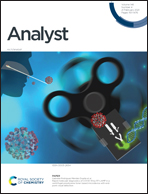Detection of locus-specific N6-methyladenosine modification based on Ag+-assisted ligation and supersandwich signal amplification†
Abstract
Emerging evidence reveals that the epitranscriptomic mark N6-methyladenosine (m6A) plays vital roles in organisms, including gene regulation and disease progression. However, developing sensitive methods to detect m6A modification, especially the identification of m6A marks at the single-site level, remains a challenge. Therefore, based on target-specific triggered signal amplification, we developed a highly sensitive electrochemical method to detect site-specific m6A modifications in DNA. In this work, the m6A site in DNA can restrict the ligation assisted by Ag+, and this restriction effect can activate the subsequent strand displacement reaction and hybridization chain reaction (HCR), thus achieving signal amplification from the m6A site, and finally realizing high sensitivity analysis of m6A methylation. Benefiting from the high specificity of base pairs and the extremely weak binding affinity between Ag+ and m6A, the proposed method was used for not only detecting the target DNA with a putative m6A site, but also identifying m6A marks at the single-site level in DNA. In addition, this study does not rely on antibodies and radiolabeling, so it has the advantage of cost-effectiveness. Therefore, we believe that the proposed strategy may provide a new perspective for methylation research, which can be used to test more clinical samples in further research.



 Please wait while we load your content...
Please wait while we load your content...